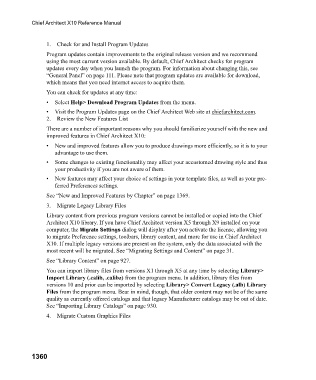Page 1361 - Chief Architect Reference Manual
P. 1361
Chief Architect X10 Reference Manual
1. Check for and Install Program Updates
Program updates contain improvements to the original release version and we recommend
using the most current version available. By default, Chief Architect checks for program
updates every day when you launch the program. For information about changing this, see
“General Panel” on page 111. Please note that program updates are available for download,
which means that you need internet access to acquire them.
You can check for updates at any time:
• Select Help> Download Program Updates from the menu.
• Visit the Program Updates page on the Chief Architect Web site at chiefarchitect.com.
2. Review the New Features List
There are a number of important reasons why you should familiarize yourself with the new and
improved features in Chief Architect X10:
• New and improved features allow you to produce drawings more efficiently, so it is to your
advantage to use them.
• Some changes to existing functionality may affect your accustomed drawing style and thus
your productivity if you are not aware of them.
• New features may affect your choice of settings in your template files, as well as your pre-
ferred Preferences settings.
See “New and Improved Features by Chapter” on page 1369.
3. Migrate Legacy Library Files
Library content from previous program versions cannot be installed or copied into the Chief
Architect X10 library. If you have Chief Architect version X5 through X9 installed on your
computer, the Migrate Settings dialog will display after you activate the license, allowing you
to migrate Preference settings, toolbars, library content, and more for use in Chief Architect
X10. If multiple legacy versions are present on the system, only the data associated with the
most recent will be migrated. See “Migrating Settings and Content” on page 31.
See “Library Content” on page 927.
You can import library files from versions X1 through X5 at any time by selecting Library>
Import Library (.calib, .calibz) from the program menu. In addition, library files from
versions 10 and prior can be imported by selecting Library> Convert Legacy (.alb) Library
Files from the program menu. Bear in mind, though, that older content may not be of the same
quality as currently offered catalogs and that legacy Manufacturer catalogs may be out of date.
See “Importing Library Catalogs” on page 930.
4. Migrate Custom Graphics Files
1360

